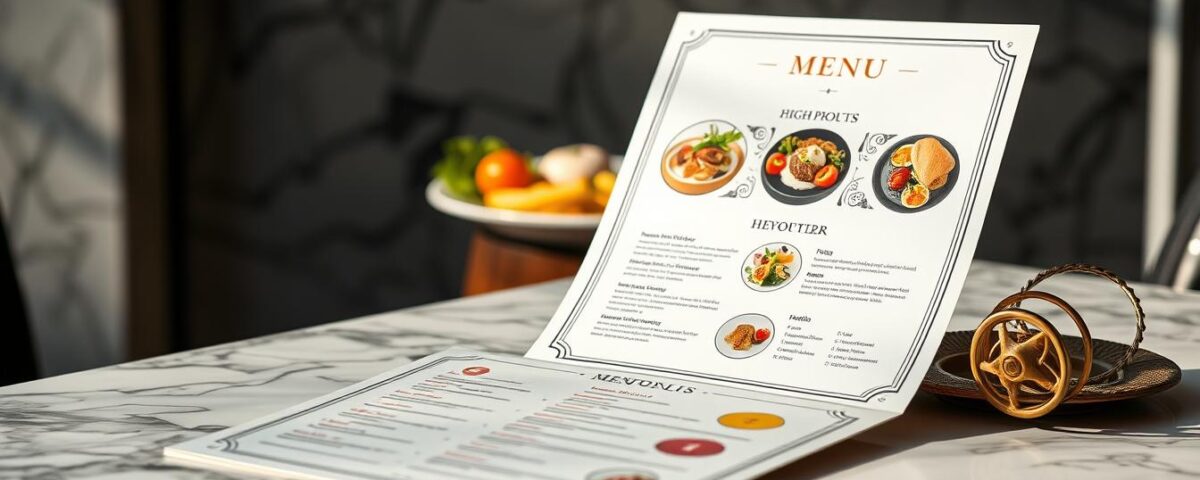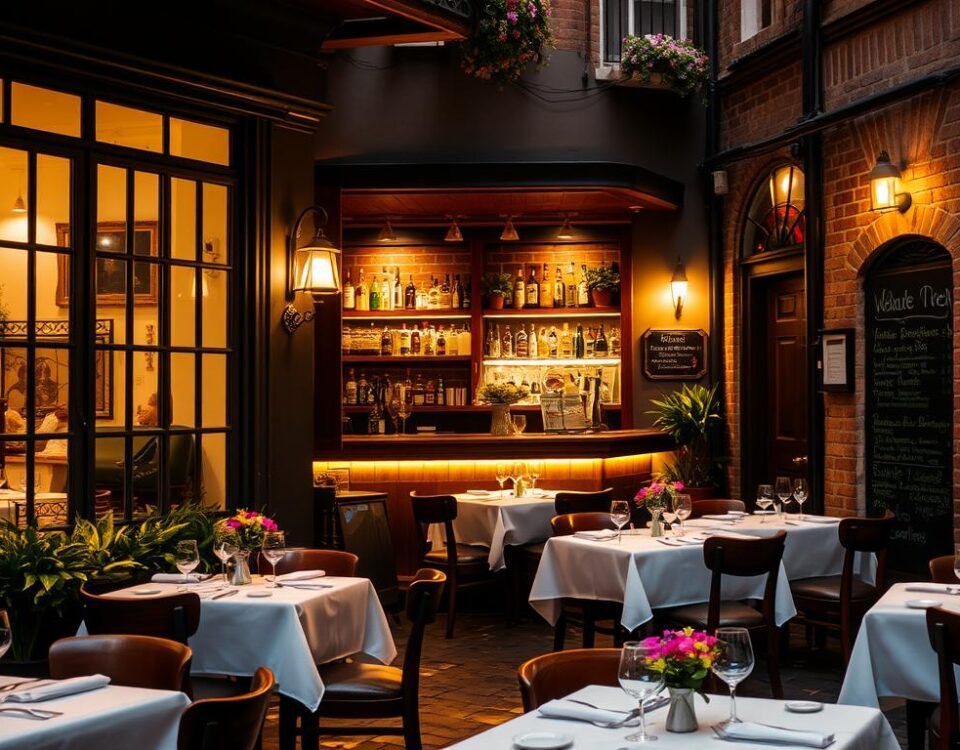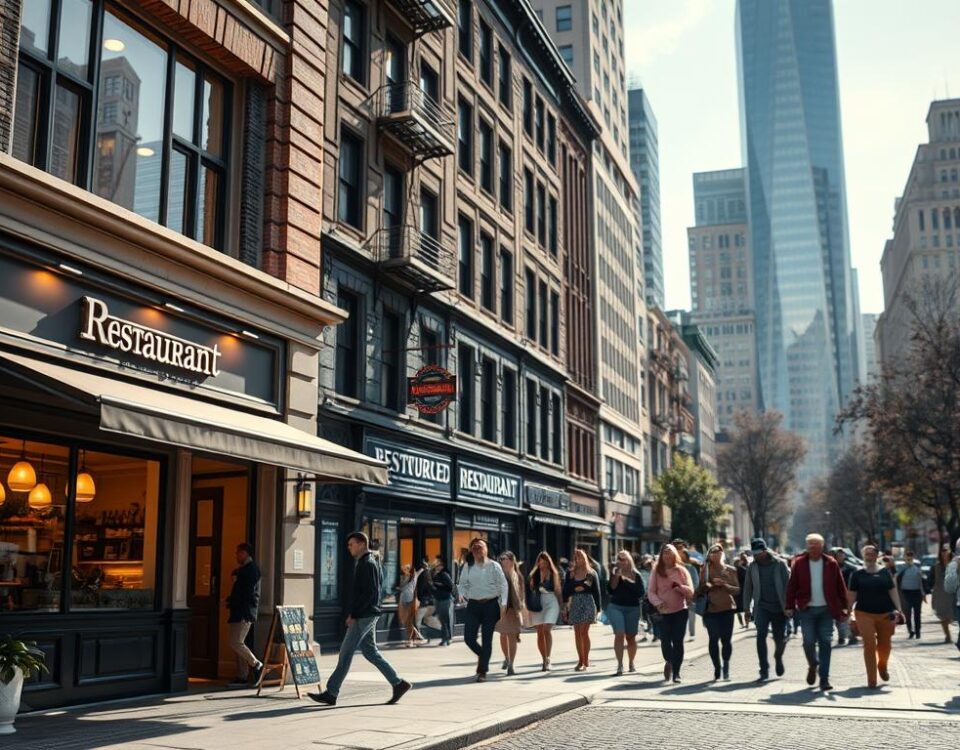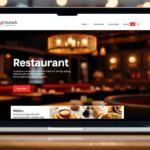
Google Ranking Guide for Restaurants: Boost Visibility and Attract More Customers
July 8, 2025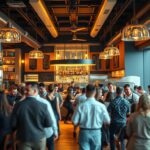
Secret Flow Techniques the Busiest Restaurants Use for Maximum Profit
July 9, 2025As a restaurant owner, I’ve seen firsthand how a well-crafted menu can make all the difference in driving sales and boosting profitability. Consider this: a study found that a typical restaurant can increase its profits by up to 15% simply by optimizing its menu design.
The way you present your dishes can subtly guide customers toward higher-profit items without them feeling manipulated. By applying strategic menu design principles, you can create a dining experience that delights your customers while also benefiting your bottom line.
So, what are the secrets to creating a menu that drives sales and profitability? Let’s dive in and explore the menu design tricks that can take your restaurant to the next level.
Key Takeaways
- Understand how strategic menu design can impact your restaurant’s profitability.
- Learn how to guide customers toward higher-profit items without manipulation.
- Discover key menu design principles to optimize your menu for better business results.
- Balance profitability with customer satisfaction for repeat business.
- Apply proven industry practices based on psychological research to your menu design.
The Psychology Behind Profitable Menu Design
Effective menu design is rooted in psychology, guiding customers toward high-profit dishes without them even realizing it. By understanding how menus influence customer decisions, restaurants can significantly enhance their profitability.
A recent survey by 99designs by Vista found that 83% of small business leaders in hospitality believe branding has a significant impact on their revenue. This underscores the importance of menu design as a critical component of a restaurant’s branding strategy.
Influencing Customer Decisions
Menus are more than just a list of dishes; they’re a powerful tool that can influence customer choices. By applying menu engineering principles, restaurants can increase their average check size and highlight high-margin items.
- Strategic item placement
- Visual emphasis techniques
- Price presentation strategies
Impact on Bottom Line
Well-designed menus can significantly impact a restaurant’s bottom line. By enhancing the dining experience, menus can lead to better reviews and repeat business. A table comparing the impact of menu design on profitability is shown below:
| Menu Design Element | Impact on Profitability |
|---|---|
| Strategic Item Placement | Increases average check size |
| Visual Emphasis Techniques | Highlights high-margin items |
| Price Presentation Strategies | Minimizes cost concerns |
Strategic Item Placement on Your Menu
Effective menu design involves more than just aesthetics; it’s about strategically positioning dishes to drive sales. When customers glance at a menu, their eyes don’t scan every item equally.
Understanding Eye Scanning Patterns
Research shows that diners tend to focus on specific areas of the menu, a phenomenon influenced by the “primacy effect.” This effect suggests that the first items listed are more likely to be noticed. Eye-tracking studies have revealed that customers often scan menus in a diagonal pattern, starting from the top left.
Where to Position Your High-Profit Items
To maximize profit, place your high-profit dishes at the top of the menu or in prominent positions within the “golden triangle” – the area that includes the center and top right sections of the menu. This strategic placement makes these items more noticeable, increasing their appeal.
| Menu Section | Recommended Item Type |
|---|---|
| Top Left | High-Profit Signature Dish |
| Center | Popular or Specialty Item |
| Top Right | Premium or Luxury Dish |
Visual Emphasis Techniques That Drive Sales
To boost sales, restaurants can utilize various visual emphasis techniques in their menu design. These techniques help draw customers’ attention to high-profit dishes and premium items, ultimately influencing their purchasing decisions.
Using Boxes and Borders to Highlight Dishes
Boxes and borders are effective tools for highlighting specific menu items. Restaurants often use these visual elements to promote dishes with high profit margins, such as pasta and other carb-based items. By enclosing these items in boxes or framing them with borders, restaurants can draw attention to them and make them more appealing to customers.
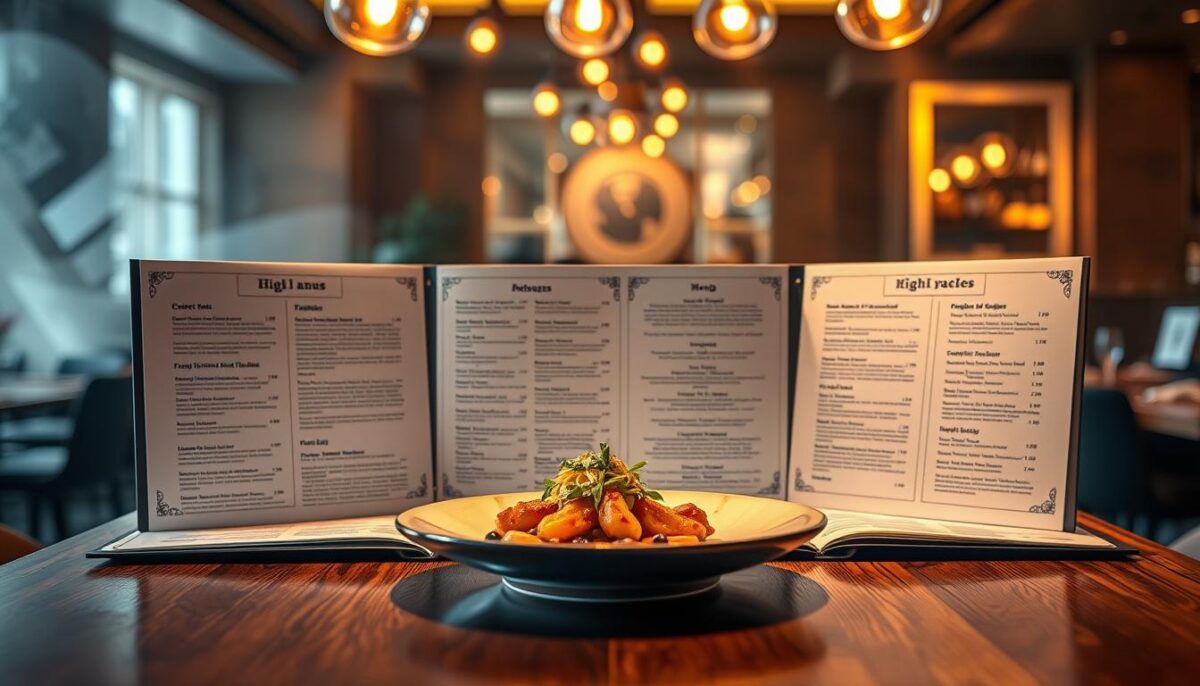
Creating White Space Around Premium Items
White space, also known as negative space, is the area between and around menu items. Strategically using white space can make premium dishes stand out without obvious visual cues. By creating a sense of importance and exclusivity around certain items, restaurants can make them more attractive to customers. Effective use of white space also contributes to the overall readability and elegance of a menu.
- Creating a sense of importance around premium dishes
- Making high-profit items more noticeable
- Enhancing menu readability
Price Presentation Strategies
The way prices are presented on a menu can significantly impact customer spending habits. Effective price presentation is crucial for influencing purchasing decisions in a restaurant setting.
The Power of Removing Dollar Signs
Studies have shown that customers are more likely to spend when currency signs are omitted from the menu. This simple trick can lead to increased sales and a more pleasant dining experience. By removing dollar signs, restaurants can make their customers less aware of the cost, encouraging them to order more.
Price Placement Tricks That Minimize Cost Concerns
Strategic price placement can de-emphasize the cost of items on the menu. Techniques include right-aligning prices, using a smaller font size for prices, and avoiding price “columns” that encourage comparison shopping. By presenting prices in a way that minimizes sticker shock, restaurants can guide customers toward their high-profit dishes.
Menu Organization That Guides Customer Choices
Organizing your menu strategically can enhance the dining experience and boost sales. A well-organized menu helps customers navigate through your offerings with ease, making it more likely for them to choose high-profit dishes.
Logical Sectioning for Maximum Impact
Dividing your menu into logical sections is crucial for maximizing its impact. This approach helps customers quickly find what they’re looking for and makes your menu less overwhelming. For instance, you can categorize your menu into sections like appetizers, main courses, and desserts.
The Magic Number: How Many Items Per Section
Research suggests that listing around seven dishes in each section is the ideal number to make customers feel like they have options without feeling overwhelmed. According to one restaurant consulting firm, this number strikes a perfect balance between variety and simplicity.
| Menu Section | Ideal Number of Items | Benefits |
|---|---|---|
| Appetizers | 7 | Variety without overwhelming customers |
| Main Courses | 7 | Simplifies decision-making |
| Desserts | 7 | Enhances customer satisfaction |
By organizing your menu into logical sections with an optimal number of items, you can guide customer choices effectively and improve their overall dining experience.
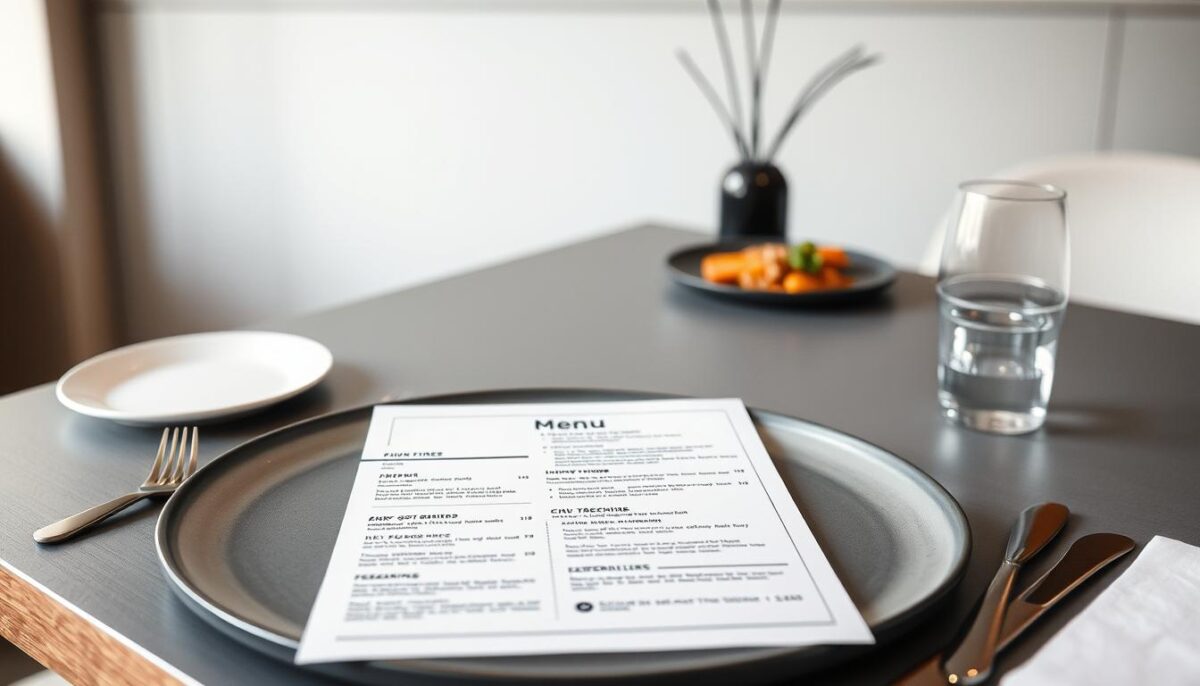
Powerful Menu Design Tricks for Dish Descriptions
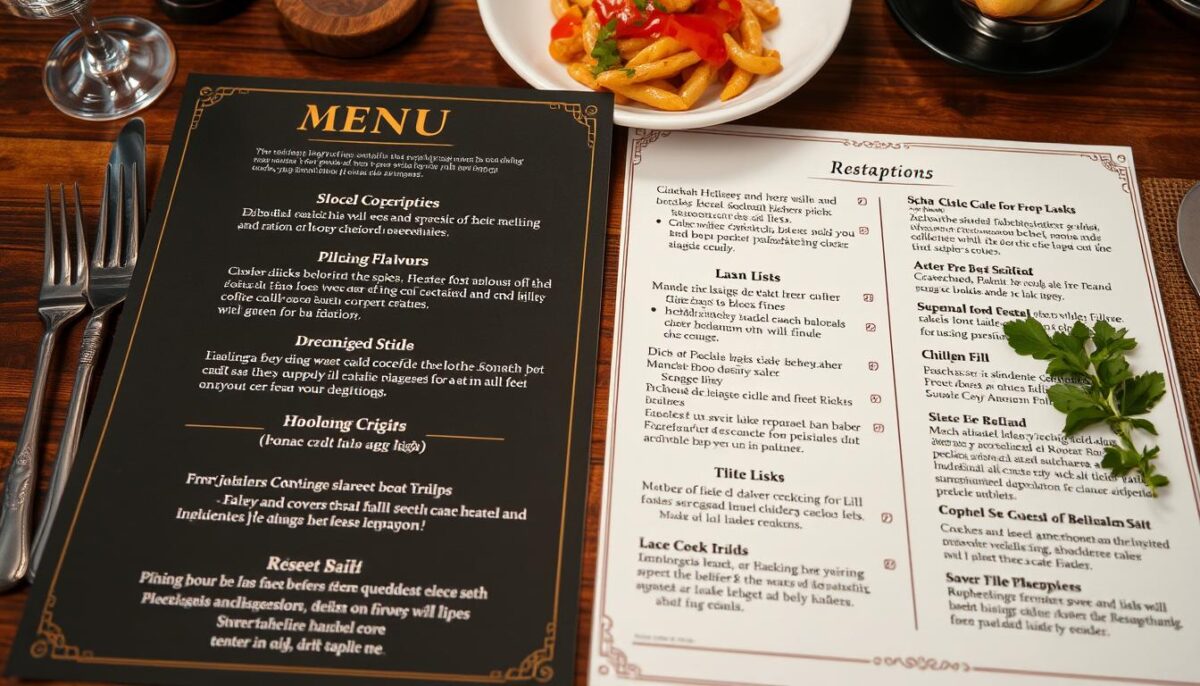
Crafting the perfect menu description is an art that can significantly influence customer choices. A well-written description can transport customers to a different culinary world, making them more likely to order a dish.
Crafting Mouthwatering Descriptions
To create effective menu descriptions, focus on using sensory language that evokes the senses. Describe the flavors, textures, and aromas of the dish to make customers’ mouths water. For example, instead of saying “grilled chicken,” say “tender grilled chicken breast marinated in a blend of herbs and spices, served with a side of roasted vegetables.”
Using Nostalgia and Emotion in Menu Copy
Using nostalgia and emotion in menu copy can be a powerful way to connect with customers. As Aaron Allen & Associates noted, “Nostalgia is a powerful force. A carefully worded description can load almost any dish with an emotional resonance that is hard to resist.” By incorporating elements of nostalgia, heritage, and tradition, you can add perceived value to your dishes and make them more appealing to customers.
Strategic Use of Visuals
The right visuals on a menu can elevate the dining experience, making it more engaging and increasing the likelihood of customers choosing high-profit items. Visual elements play a crucial role in capturing attention and guiding customer decisions.
When and How to Use Food Photography
Food photography can be an effective way to showcase dishes, but it’s not always the best choice. High-quality photos can stimulate appetite and create a positive first impression. However, poor photography can have the opposite effect, deterring customers from ordering.
The Advantage of Illustrations Over Photos
Illustrations offer a unique alternative to photography. They can be more universally appealing and help communicate a restaurant’s personality. Different illustration styles can complement various cuisine types and restaurant concepts, creating a distinctive menu style.
| Visual Element | Advantages | Disadvantages |
|---|---|---|
| Food Photography | Stimulates appetite, realistic representation | Can be costly, may not always be appealing |
| Illustrations | Universally appealing, conveys brand personality | May not be as realistic, requires creative skill |
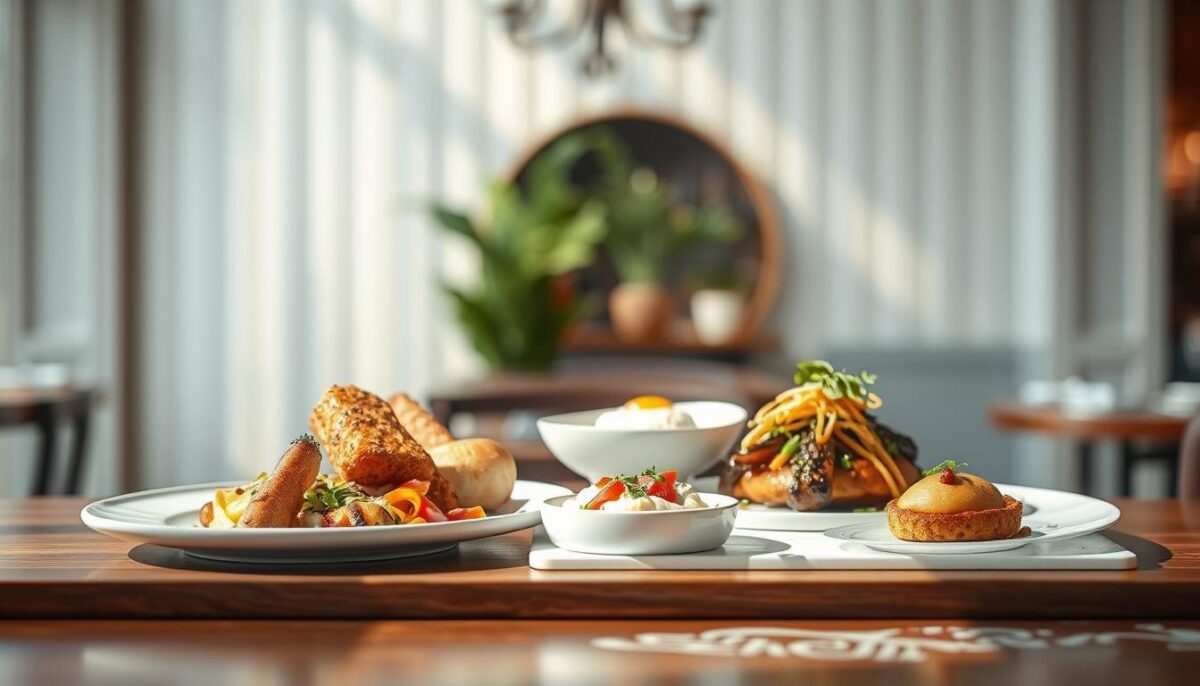
When choosing between photography and illustrations, consider the restaurant’s identity and the message you want to convey. Illustrations can be particularly effective for creating a unique and memorable menu design.
Color Psychology in Menu Design
The strategic use of colors in your menu can enhance the overall dining experience and drive sales. When choosing the colors for your menu, think about the way you want your customers to feel when they’re in your restaurant.
How Different Colors Affect Appetite
Different colors can stimulate appetite and influence customer emotions. For instance, warm colors like red and orange can increase heart rate and stimulate appetite, while cool colors like blue can have a calming effect.
- Red: Stimulates appetite and increases energy
- Orange: Encourages social interaction and appetite
- Blue: Can reduce appetite but creates a calming atmosphere
Matching Colors to Your Restaurant’s Identity
It’s crucial to match the colors of your menu to your restaurant’s identity and atmosphere. Consistency in design across all touchpoints enhances brand recognition. Consider your restaurant’s concept, cuisine, and target audience when selecting colors.
Typography and Readability Considerations
Effective menu design relies heavily on typography to communicate your restaurant’s brand and enhance legibility. The choice of typeface can significantly impact how customers navigate your menu.
Choosing the Right Fonts for Your Menu
Selecting the appropriate font for your menu is crucial. It depends on several factors, including the amount of text that needs to fit on the page. Using more than one typeface can help distinguish between different elements, such as item names and descriptions.
For instance, a serif font can be used for descriptions to add a touch of elegance, while a sans-serif font can be used for item names to ensure clarity.
Font Size and Hierarchy That Guides the Eye
Creating a typographic hierarchy is essential to guide customers through your menu strategically. This involves using different font sizes for headers, item names, descriptions, and prices.
A well-structured hierarchy can be achieved by using a larger font size for headers and item names, while descriptions and prices are presented in a smaller, yet still readable, font size.
| Menu Element | Recommended Font Size | Font Style |
|---|---|---|
| Headers | 18-20 pt | Bold |
| Item Names | 14-16 pt | Regular |
| Descriptions | 10-12 pt | Italic |
| Prices | 12-14 pt | Regular |
Implementing These Strategies Without Alienating Customers
A well-designed menu can increase profitability while maintaining customer trust and satisfaction. To achieve this balance, it’s crucial to implement menu design strategies ethically.
If a restaurant encourages a diner to purchase more than they want, they may overeat or feel bad about wasting food or money. This negative experience can deter customers from returning. Therefore, it’s essential to balance profitability with customer satisfaction.
To do this, I recommend testing menu changes gradually to gauge customer response. This can be done by introducing new items or layouts in a controlled manner, allowing for feedback and adjustments before a full rollout.
Training staff to support menu design strategies is also vital. They should be able to make recommendations that align with the menu’s design, enhancing the overall dining experience.
Gathering and responding to customer feedback about menu changes is another key aspect. This not only shows customers that their opinions are valued but also helps in making informed decisions about future menu adjustments.
Maintaining authenticity while optimizing menu design is crucial. Restaurants should ensure that their menu remains true to their brand and values, even as they make changes to increase profitability.
By following these guidelines, restaurants can successfully implement menu design strategies that drive sales without alienating their customers, ultimately enhancing the dining experience.
Conclusion
As we’ve explored throughout this article, menu design plays a vital role in shaping the dining experience and driving sales. By applying the strategies discussed, such as strategic item placement and visual emphasis techniques, restaurants can guide customers toward satisfying choices. This approach benefits both the restaurant and its customers. I encourage restaurant owners to view their menus as powerful marketing tools worthy of investment. Start by implementing one or two strategies at a time, measuring results, and evolving your menu design over time based on customer feedback and changing trends.
FAQ
How can I make my restaurant’s menu more appealing to customers?
To make your menu more appealing, use a clear and concise format, highlight your high-profit dishes, and incorporate food photography or illustrations that showcase your dishes in an appetizing way.
What is the best way to organize my menu to guide customer choices?
Organize your menu into logical sections, use clear headings, and limit the number of items per section to avoid overwhelming customers. This will help guide their choices and make the decision-making process easier.
How can I use price presentation to minimize cost concerns?
To minimize cost concerns, consider removing dollar signs from your prices and strategically placing prices to draw attention away from them. You can also use anchoring by placing a high-priced item next to a lower-priced one to make the latter appear more reasonable.
What role does color psychology play in menu design?
Colors can significantly impact appetite and emotions. For example, red can stimulate appetite, while blue can suppress it. Choose colors that match your restaurant’s identity and appeal to your target audience.
How can I use typography to improve my menu’s readability?
Select fonts that are clear and easy to read, and use a font hierarchy to draw attention to important information. Avoid using too many font styles or sizes, as this can create visual clutter.
Should I use photos or illustrations on my menu?
Both photos and illustrations can be effective, depending on your restaurant’s style and the type of cuisine you serve. Food photography can be particularly effective for showcasing dishes in a realistic and appetizing way, while illustrations can add a touch of personality and whimsy.
